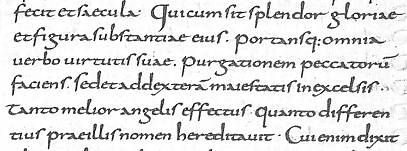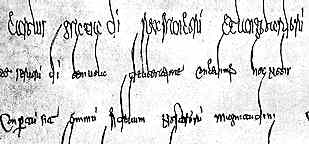






If you are looking at this page without frames, there is more information about medieval writing to be found by going to the home page (framed) or the site map (no frames).
| Scripts and Hands (3) | |||
| The development of Caroline minuscule produced one basic script prototype for the whole of western Christendom. Growing from its precursor, Germanic minuscule, it was gradually adopted all over western Christendom, although it took several centuries to be fully accepted in those areas where regional scripts had developed their own ethnic significance. In England the distinction between church identity and ethnic identity was emphasised by the fact that into the 12th century, Latin was written in Caroline minuscule and English in insular minuscule. In the 8th, 9th, 10th and 11th centuries, literacy was still a church matter, and the needs of the church were driving change. | |||
 |
Segment from a Vulgate Bible as revised by Alcuin of York, written at Tours around the middle of the 9th century (British Library add. ms. 10646). (From Fairbank 1952 ) | ||
| The spread of Caroline minuscule was not a fashion craze. It coincided with a process of regularising the text of the Bible, and therefore the liturgy, all over the western Christian world. While the Vulgate of St Jerome had been around for some centuries, many ecclesiastical institutions had copied their texts from other Old Latin versions. They were not all the same. Now if you are going to regularise texts across nations and continents, then you have to be sure that all texts are readable by everybody. Caroline minuscule became a strong prototype, selected not only for its elegance, but for its extreme readability. As shown by the two examples at the beginning of this section, it is still possible to have recognisably different hands, but they are all able to be read by anyone who has learned the graphic code of the script. | |||
| At the same time as all this was going on, there were creeping developments in the significance of the written word in legal matters. As described in other sections, legal documents were originally recordings of decrees or transactions that were carried out as witnessed oral testimony. The documents may have contained a load of flowery language, but it did not necessarily mean very much in terms of the specifics of the case. It was an object that indicated under which authority a document was granted and who was there at the time. The words were probably of less importance than the signifiers of authenticity of the document. The oldest literate institutions each had their particular house style of script, which was a strong script prototype, but only for particular classes of document. | |||
 |
This very small segment comes from a fragment of a bull or privilege of Pope John VIII, of 876 (Paris, Bibliothèque Nationale, Ms lat 8840). (From Steffens 1929) | ||
| The oldest of the chanceries, that of the papal curia, had its own script for bulls or privileges. It has been dubbed curialis, and while it changed over time, at all times it had its own unique characteristics so that it was always identifiable even if it could not be read. | |||
 |
Small segment from a diploma of Charlemagne, of 781, granting land to the monastery of Fulda (Marburg, K. Preussisches Staatsarchiv). (From Steffens 1929) | ||
| The distinctive Merovingian chancery script, used for formal Frankish royal diplomas, continued into the time of Charlemagne. Unlike the literary works of the church, recognisability of these documents as objects emanating from a certain authority was more significant than actual legibility. Interestingly, it is possible, even probable, that the same monastic scribes who were copying out liturgical works with ever increasing legibility were responsible for this very different, extremely mannered script. Probably the same applied in the Vatican. There were different models for scripts with different functions. | |||
| In Anglo-Saxon England, the processes of law and government were basically illiterate. Surviving charters from this era do not suggest a strong model either for the form and wording, or for the script, and they were probably written out in monasteries using the general literacy skills of the monks. They may appear in insular minuscule or Caroline minuscule script little different to book hands. The particularly English form of writ evidently introduced by Edward the Confessor utilised insular minuscule script. There was no long tradition of using a unique script style as an identifier of authority. | |||
| Around the 12th century there began the rumblings of an explosion in lay literacy. Aristocratic lay people not only became able to read, and sometimes write, but more and more emphasis was laid on written processes in law, government and commerce. More levels and layers were introduced into the types of written record. Furthermore, just having a piece of parchment with a fancy seal and a bit of elaborate calligraphy was not enough. It became important to actually read the writing. The letter forms and logic of Caroline minuscule were introduced into the chancery scripts. However, at the highest level, they still had to have their distinguishing calligraphic features. | |||
 |
|||
| This segment is from a papal bull or privilege of Pope Eugenius III of 1147 (British Library, Cotton Cleopatra E I, f.123), taking under his possession the abbey of St Mary at Saltrey. (From New Palaeographical Society 1904) | |||
| The example above shows the script of the most formal type of papal document. The basic letter forms are those of Caroline minuscule, but with some extremely exaggerated features, such as very long and decorative ascenders with tiny little bodies to the letters, some totally weird extended ligatures and even a twiddly curly form of abbreviation mark known as the papal knot. This extreme script gets called diplomatic minuscule, because it was used for writing diplomas, the most formal type of documents. It is a strong script model, but very specialised. In fact, I have a darkling suspicion that they could probably do nasty things to you if you tried to emulate it in inappropriate circumstances. | |||
 |
This segment is from a diploma of the emperor Conrad III of 1139. (From Steffens 1929) | ||
| The German emperors were not going to be outdone by the papacy. This example of diplomatic minuscule is possibly even sillier than the one above it. | |||
| The above examples are at one end of the spectrum of styles produced by these agencies. As with the church functionaries themselves, the letters, mandates and privileges produced by the Vatican were very hierarchical. It was even significant to the grade of communication as to what kind of cord was used to attach the bulla, or papal seal. The basic underlying forms of letters did not change much over the grades, or over many centuries, but the calligraphic elaborations and additional paraphernalia of the documents varied to suit the grade of communication. Do we call these variants scripts or hands? I am really not quite sure. The point is, if you have before you only one exemplar of, say, a 14th century papal document, the script may not look exactly like the one you are trying to read. However, if you carefully analyse each letter of the alphabet, you should be able to work it out. You have the code, but not necessarily a facsimile for your piece of writing. | |||
 |
|||
| Tiny sample of writing from a fragment of a papal brief of Pope Benedict XII (1334 -1342), from a private collection. | |||
| As discussed in other sections, the transition from Caroline minuscule to Gothic was not a revolutionary change in terms of letter forms; it was a change in style. Furthermore, it involved a proliferation of styles as writing was practised more widely and for a range of purposes. It is at this time that establishing clear models for script styles starts to become very problematical. However, amongst all the diversity of the late medieval world of literacy, there are certain models for identifiable scripts, based on their uses and the agencies that used them. | |||
| The English royal chancery developed a distinctive script style for documents, that was recognisably different to that used for books, in the 12th century. It was not restricted to documents issued by the crown, but also used for private charters, more than likely written by the same scribes. It had a rather spiky appearance, and is likely to be simply referred to as a protogothic charter hand. | |||
| This sample comes from a charter of the latter part of the 12th century (British Library, add. chart. 47424), in which a nobleman, Gervaise Payne, gives a mill to the nuns of Etonia, or Nuneaton, of the order of Fontevrault. By permission of the British Library. | |||
| Some documents were written at this time in scripts indistinguishable from book hand, often because they were actually written out by scribes in the monasteries and ratified by seal and by witnesses. So there is such a thing as English protogothic document script, but it is not the only one used for the purpose. Lower grades of documents, such as writs, are distinguished mainly by less care and attention in the writing than in real differences in letter forms. | |||
 |
|||
| This is the complete text of a Latin writ of Henry II, dated 1156-166 (New College, Oxford. Takeley No. 136). (From Salter, 1929, No.31) | |||
| |
|||
| |
|||
|
|
|||
|
If you are looking at this page without frames, there is more information about medieval writing to be found by going to the home page (framed) or the site map (no frames). |
|||